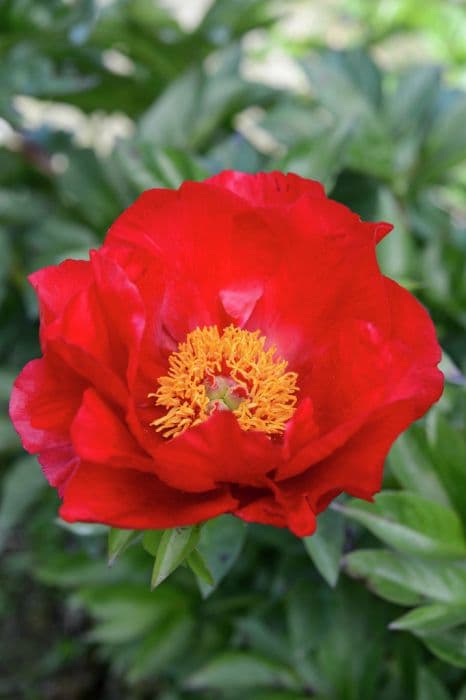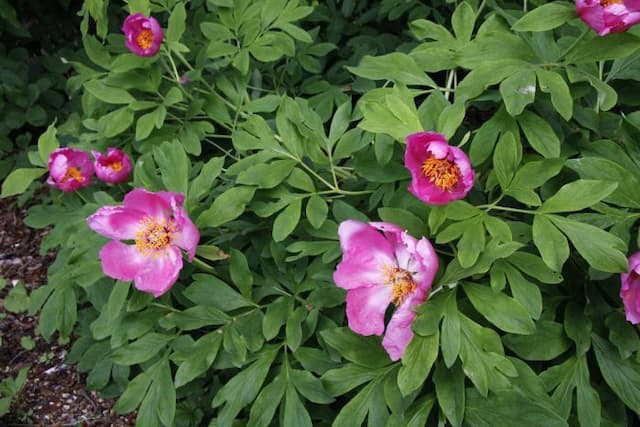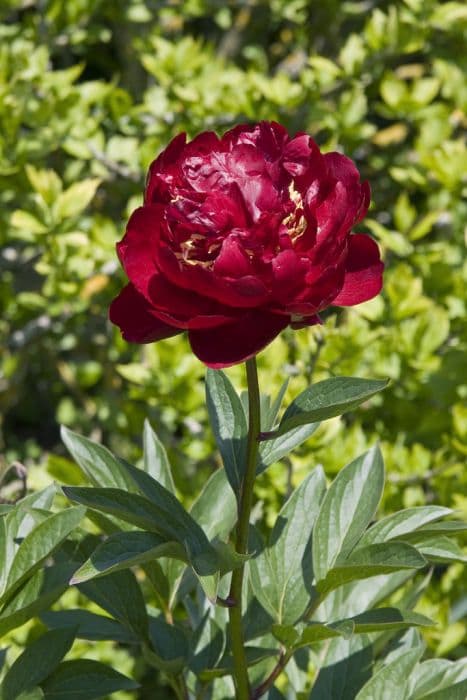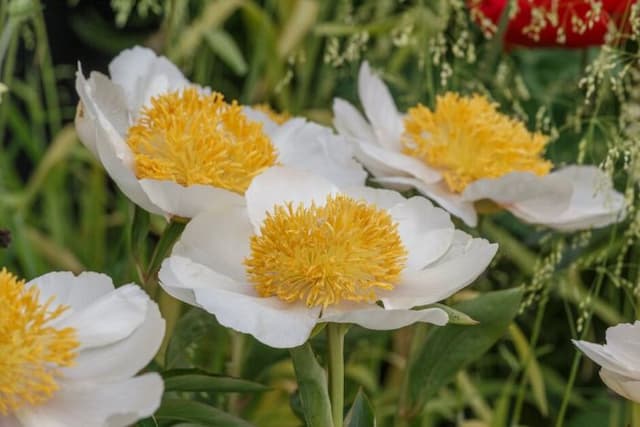Peony Paeonia 'Blaze'

ABOUT
The Paeonia 'Blaze' is a vibrant and showy flower that is part of the peony family. This particular peony variety is known for its striking red blooms which are sure to make a bold statement in any garden. Each flower boasts a large, cup-shaped appearance that captures attention with its lustrous, satiny petals. The petals radiate outwards from a central cluster of yellow stamens, which add a lovely contrast to the deep red color of the petals. The leaves of the 'Blaze' are deep green, providing a lush backdrop for the spectacular flowers. The plant presents a tidy and attractive form with its leaves growing compactly on sturdy stems. This adds a sense of structure to garden designs and provides excellent support for the blooms. As a perennial, this peony brings recurrent enjoyment, with foliage that emerges fresh in the spring and blooms that typically appear in mid to late spring. Overall, the 'Blaze' peony exudes a classic charm with its vivid blossoms and is coveted for its reliable display of color and beauty in ornamental gardens. Its appearance can evoke an air of romance and its blooms are often used in floral arrangements to add a touch of elegance.
About this plant
 Names
NamesSynonyms
Peony, Garden Peony
Common names
Paeonia 'Blaze'.
 Toxicity
ToxicityTo humans
Peonies, including the variety 'Blaze', are generally considered non-toxic to humans. However, it's important to note that eating large quantities of peony parts such as leaves, flowers, or roots could potentially cause gastrointestinal irritation, nausea, diarrhea, or an upset stomach. While not highly toxic, it's still advisable to avoid consuming any parts of the peony plant. If you suspect someone has ingested a significant amount of the plant and is exhibiting adverse symptoms, consult with a medical professional.
To pets
Peonies, including the variety 'Blaze', can be toxic to pets if ingested. The toxicity level is generally considered mild to moderate. Symptoms of peony poisoning in pets may include vomiting, diarrhea, and drooling. If a pet consumes a large amount of the plant, more severe gastrointestinal upset could potentially occur. It is recommended to keep peonies, especially the 'Blaze' variety, out of reach of pets and to consult a veterinarian if you suspect your pet has ingested part of a peony plant.
 Characteristics
CharacteristicsLife cycle
Perennials
Foliage type
Deciduous
Color of leaves
Green
Flower color
Red
Height
2-3 feet (60-90 cm)
Spread
2-3 feet (60-90 cm)
Plant type
Shrub
Hardiness zones
3-8
Native area
Asia
Benefits
 General Benefits
General Benefits- Aesthetic Appeal: Paeonia 'Blaze', commonly known as peony, offers vibrant red flowers that can enhance the beauty of any garden.
- Longevity: Peonies are known for their longevity, often living for decades and becoming a garden staple.
- Fragrance: The peony produces a delightful fragrance that can add an aromatic touch to gardens and cut flower arrangements.
- Pollinator-Friendly: Peonies attract bees and other pollinators, which are essential for the health of the ecosystem.
- Low Maintenance: Once established, peonies require minimal care, making them suitable for gardeners of all skill levels.
- Seasonal Interest: Peonies have a distinct blooming season in late spring to early summer, providing seasonal interest in the garden.
- Cut-Flower Use: The large blooms of peonies hold up well in vases, making them excellent for cut-flower arrangements.
- Drought Tolerance: Peonies are relatively drought-tolerant once they are well-established, which is beneficial for water conservation.
- Cold Hardy: Peonies are capable of enduring cold winter temperatures, which makes them suitable for gardens in cooler climates.
 Medical Properties
Medical PropertiesThis plant is not used for medical purposes.
 Air-purifying Qualities
Air-purifying QualitiesThis plant is not specifically known for air purifying qualities.
 Other Uses
Other Uses- The petals of the peony 'Blaze' can be crystallized and used as edible decorations for desserts and cakes, adding a touch of elegance and a floral note to culinary presentations.
- Dried peony petals can be incorporated into potpourri blends to create a natural and fragrant home deodorizer, spreading the peony's pleasant aroma around living spaces.
- Peony petals can be used to create natural dyes for fabrics, offering a subtle and unique hue for textiles and craft projects.
- The peony 'Blaze' can serve as a muse for artists and photographers, inspiring paintings, photographs, and other forms of artwork with its vibrant colors and aesthetic blooms.
- These flowers can be used in floral waters or perfumes for a light, natural scent that captures the essence of peonies without the use of artificial fragrances.
- As an addition to handmade papers, peony 'Blaze' petals can be embedded into the paper during the creation process for a decorative effect that is especially popular for invitations or stationery.
- Insect-friendly gardens can utilize peony 'Blaze' to attract pollinators such as butterflies and bees, supporting local ecosystems and biodiversity.
- During blooming season, peony flowers can serve as a dramatic backdrop for events and ceremonies such as weddings or garden parties, contributing a naturally stunning environment.
- Peony blooms can be floated in bowls of water to create simple yet sophisticated table centerpieces for restaurants, hotels, or home décor.
- In the language of flowers, peonies like 'Blaze' can be gifted to convey messages of good luck, prosperity, and happy marriage, making them a meaningful choice for bouquets and floral gifts.
Interesting Facts
 Feng Shui
Feng ShuiThe Peony is not used in Feng Shui practice.
 Zodiac Sign Compitability
Zodiac Sign CompitabilityThe Peony is not used in astrology practice.
 Plant Symbolism
Plant Symbolism- Prosperity: Peonies, including the Paeonia 'Blaze', often symbolize prosperity due to their full, round blooms that are associated with abundance and good fortune.
- Romance: With their lush petals and vibrant colors, peonies are commonly associated with romance and romantic love, making them a popular choice for weddings and anniversaries.
- Honor and Nobility: In many cultures, the peony is considered a symbol of honor and nobility, reflecting its status in society as a prized and respected flower.
- Beauty: Peonies embody the idea of beauty in its many forms, celebrating natural elegance and aesthetic appeal.
- Good Luck and Happiness: The peony is often considered a good luck charm, believed to bring happiness and positive outcomes to those who grow or receive them.
 Water
WaterPeonies like 'Blaze' should be watered deeply once a week during their growing season, ensuring the soil is moist but not waterlogged. Typically, they require about 1 inch of water per week, which can be adjusted depending on rainfall, with less frequent watering as they go dormant. In terms of volume, this translates to about 0.62 gallons per square yard of soil each week. During hot and dry periods, you may need to water twice a week, but always check the soil moisture first to prevent overwatering.
 Light
LightPeonies such as 'Blaze' thrive in full sun to part shade conditions. They perform best with at least six hours of direct sunlight daily. The ideal spot for a 'Blaze' peony would be an area where it can receive morning sun and some afternoon shade, especially in hotter climates to prevent the flowers from fading too quickly.
 Temperature
Temperature'Blaze' peonies are cold-hardy plants and require a period of winter chill to bloom successfully. Their ideal growing temperature range is between 65°F and 75°F. They can withstand winter temperatures down to about -20°F and summer temperatures as high as 85°F. However, prolonged exposure to temperatures above this range can impede their growth and flowering.
 Pruning
PruningPrune 'Blaze' peonies in the fall after the foliage has died back, to remove dead or diseased foliage and help prevent fungal diseases. Cutting the stems down to about 3 inches above the ground helps ensure the plant's energy is directed into the roots for next year's growth. The best time for pruning is after the first frost when the leaves have turned brown.
 Cleaning
CleaningAs needed
 Soil
SoilPeonies such as 'Blaze' prefer well-draining soil rich in organic matter with a neutral to slightly alkaline pH, ideally between 6.5 and 7.5. A blend of loamy garden soil, compost, and perlite or coarse sand can create an optimal growing environment. Ensuring good drainage is crucial as peonies do not tolerate wet feet.
 Repotting
RepottingPeonies like 'Blaze' rarely need repotting as they are typically garden perennials. However, if grown in containers, they may require repotting every 3 to 4 years. It’s best done in the fall after the foliage has died back.
 Humidity & Misting
Humidity & Misting'Blaze' peonies prefer average outdoor humidity levels. They do well in a typical garden environment without the need for additional humidity adjustments.
 Suitable locations
Suitable locationsIndoor
Peonies like 'Blaze' are difficult to grow indoors due to their size and light needs.
Outdoor
Plant 'Blaze' peony in sun-rich spot with well-draining soil.
Hardiness zone
3-8 USDA
 Life cycle
Life cycleThe life cycle of the peony 'Blaze' begins with seed germination, which can be slow and may require a period of cold stratification to break dormancy. The germinated seeds develop into young plants with a small rosette of leaves close to the soil surface. Following a juvenile phase which can last several years, the plant enters its maturity stage, where it establishes a robust root system and begins to produce stems and foliage annually. During spring, mature 'Blaze' peonies produce large, vivid red flowers that are attractive to pollinators. After blooming, the plant sets seed in the form of capsules which ripen during summer. As autumn approaches, the aerial parts of the plant die back to the ground, and the plant enters dormancy, with the root system surviving the winter to regenerate the next spring.
 Propogation
PropogationPropogation time
Late summer to early fall
Propogation: The most common method of propagation for the Peony 'Blaze' is division, which is ideally done in the fall after the plants have flowered and the leaves have died back. To propagate by division, the entire plant is carefully dug up and the clumps are separated ensuring that each division has at least three to five eyes, which are the small red buds that will become next year's shoots. The divided clumps should then be planted so that the eyes are no deeper than 2 inches (about 5 centimeters) below the soil surface. Proper spacing is crucial to allow adequate air circulation and prevent crowding; typically, peonies should be spaced about 3 feet (approximately 91 centimeters) apart. After planting, the divisions should be watered thoroughly to settle the soil around the roots.









